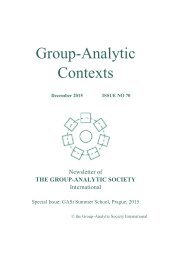Group-Analytic Contexts, Issue 80, June 2018
You also want an ePaper? Increase the reach of your titles
YUMPU automatically turns print PDFs into web optimized ePapers that Google loves.
Newsletter – Summer <strong>2018</strong> 61<br />
conjoint therapy he had the opportunity to split the good and the bad<br />
transference. Sometimes the conductor, sometimes the group and<br />
sometimes the individual therapist were the bad ones or the good ones.<br />
It changed and helped him to access his own behaviour. The therapy<br />
is still going on.<br />
Conclusion<br />
In my opinion a patient’s fear of becoming part of an unknown group<br />
is often the fear of an existential threat or danger to the security of his<br />
identity. Many patients are less anxious and therefore benefit more<br />
when treated in individual and group therapy. Some patients only can<br />
decide to step into a group therapy because they are offered individual<br />
sessions too.<br />
A psychoanalytic group needs a good temperature to work<br />
together – not too hot and not too cold. It is important that each group<br />
member takes an active part in every single group session. The fear to<br />
speak spontaneously should be low in order to achieve a lived process<br />
and to have fun working together. Every patient should get the<br />
individual support that he needs to start the therapy which will help<br />
him and to get support to develop well during therapy. To be treated<br />
equally it is necessary to treat every patient in the way he needs, and<br />
this might be very different for each patient.<br />
Bibliography<br />
Kauff, P. (2009) Transference in Combined Individual and <strong>Group</strong><br />
Psychotherapy. International Journal of <strong>Group</strong><br />
Psychotherapy, 59, 1-28<br />
Türk, D. (2016) Kombinierte und parallele Einzel- und<br />
Gruppentherapie - immer noch ein rotes Tuch?<br />
Gruppenpsychother. Gruppendynamik 52/2016, 288-301<br />
Türk, D. (2017) Warum Gruppe Spaß macht - zur Persönlichkeit des<br />
Gruppenleiters Gruppenpsychother. Gruppendynamik<br />
53/2017, 341-352<br />
Wöller, W. (2016) Der ausreichend gute Therapeut. Psychotherapeut<br />
61, 105-109<br />
Hayne, M. (1999) Die Indikationsstellung in der Gruppentherapie.<br />
HTTP://www.gruppenanalyse-aussee.com/vortraege/indikat.htm<br />
Dorothe Türk<br />
dorothe.tuerk@googlemail.com













